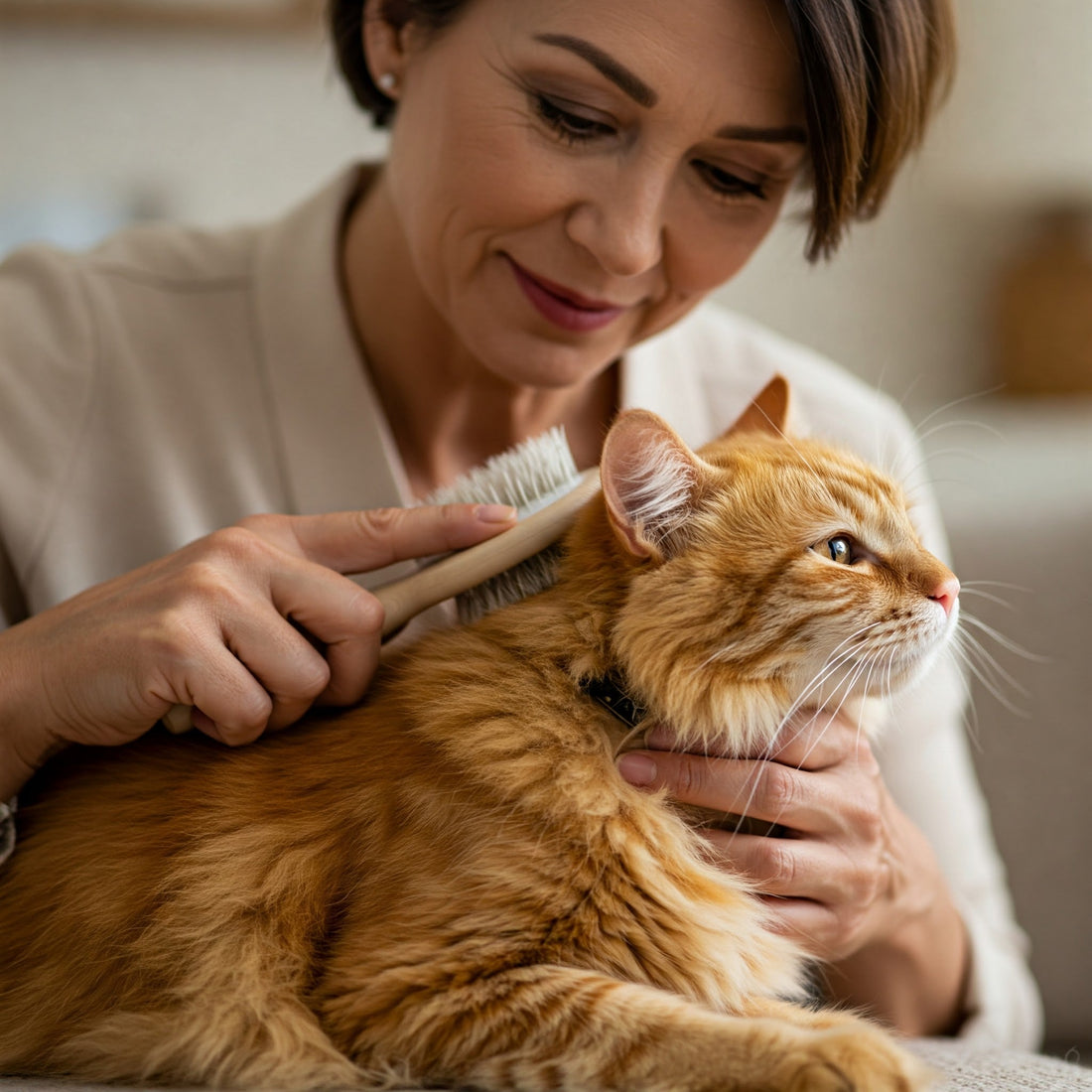
Natural Remedies for Common Coat Problems: DIY Solutions for Dander and Matting
Share
The softest part of your cat—that luxurious fur that invites endless strokes—can become a source of discomfort when dander flakes like winter snow or mats form like stubborn tangles in a favorite sweater. These common coat problems often send well-meaning cat parents scrambling for chemical-laden solutions, unaware that nature provides equally effective remedies hidden in kitchen pantries and garden shelves. The secret lies in working with your cat's biology rather than against it, using ingredients that soothe irritated skin, loosen dead fur, and restore the coat's natural balance without stripping essential oils or triggering stress.

What Natural Remedies Help With Cat Dander and Shedding?
Dander, those tiny white flakes that dust your black pants, stems not from dryness alone but from an imbalance in the skin's ecosystem. Commercial anti-dander sprays often exacerbate the problem by masking symptoms with perfumes while disrupting the acid mantle—the protective barrier that keeps skin hydrated and resistant to irritation. A simple rosemary rinse, made by steeping fresh rosemary sprigs in boiling water and cooling the infusion, acts as a gentle antiseptic that calms flaking without harshness. The herb's cineole compounds improve circulation to hair follicles while its subtle scent pleases feline noses far more than synthetic fragrances. Applied with a soft cloth during brushing sessions, this herbal tonic removes loose dander while leaving behind trace minerals that nourish the skin. For stubborn cases, adding a teaspoon of apple cider vinegar to the rinse helps restore the skin's natural pH—just enough to be effective but diluted sufficiently to avoid any stinging sensation.
Mats—those dreaded felted clumps that seem to appear overnight—require a more strategic approach than brute-force cutting. The instinct to grab scissors is understandable but dangerous; even small skin folds can become accidental casualties. Instead, a paste of cornstarch and coconut oil worked gently into the base of the mat with your fingers creates a safe lubricant that helps separate hairs. The cornstarch absorbs excess oils that contribute to clumping, while the coconut oil's medium-chain fatty acids soften keratin bonds between hairs. As the paste sits for ten minutes (a perfect window for treats and praise), the mat loosens enough to be teased apart with a mat comb or even your fingers. This method preserves the coat's length and prevents the uneven patches that result from cutting, all while turning a stressful grooming session into a bonding experience. For long-haired cats prone to matting, a weekly preventive treatment of arrowroot powder brushed through the coat absorbs oils before they can cause tangles, acting as a dry shampoo between baths.
Seasonal shedding transforms even shorthaired cats into walking tumbleweeds, but the solution isn't more frequent baths—it's smarter brushing techniques. A rubber grooming glove worn during your evening petting sessions captures loose fur more effectively than most brushes, leveraging your cat's natural enjoyment of touch to remove dead hair before it spreads across your furniture. The glove's nubs stimulate sebaceous glands to distribute natural oils evenly through the coat, preventing the dry patches that exacerbate shedding. For dense undercoats, a slicker brush followed by a pass with a dampened chamois cloth lifts away an astonishing amount of loose fur while leaving the topcoat sleek. The chamois mimics the texture of a mother cat's tongue, triggering nostalgic grooming behaviors that make cats more tolerant of the process.

Skin irritations—those red patches that prompt endless scratching—often respond beautifully to oatmeal's soothing magic. Unlike medicated shampoos that require stressful full-body immersion, an oatmeal poultice can target specific hotspots. Grind rolled oats into a fine powder, mix with warm water to form a paste, and apply directly to irritated areas. The avenanthramides in oats reduce inflammation while the sticky consistency gently lifts away crusts and debris. After fifteen minutes (or however long your cat tolerates), a soft toothbrush can remove the residue along with any loosened scabs. For widespread irritation, a mesh wash bag filled with oatmeal tied under the faucet creates an instant soothing bath without the mess of loose oats swirling down the drain.
The base of the tail—that oily zone where mats and blackheads congregate—demands special attention. Harsh degreasers strip away too much oil, prompting glands to overcompensate with increased production. Instead, a cornstarch and bentonite clay mask applied weekly absorbs excess oil without disrupting natural lubrication. The clay's minerals draw out impurities while the cornstarch prevents caking, leaving the area clean but not parched. A soft baby toothbrush gently massaged in circular motions helps dislodge blackheads without irritating delicate skin. This preventive care avoids the painful clogs that lead to stud tail, a condition where overactive glands create waxy plugs resembling acne.
Paw pads, often overlooked in coat care, harbor hidden dryness and cracks that cause discomfort. While commercial balms abound, a simple blend of beeswax, shea butter, and a drop of vitamin E oil creates a protective barrier that's safe even if licked. The trick lies in applying it just before play or meals—activities that naturally distract from paw-licking until the balm absorbs. For cats who absolutely won't tolerate paw handling, placing the balm on a scratching post lets them self-apply while engaging in normal behavior.
Ears—those velvety triangles that frame your cat's face—collect debris that can migrate into the coat. A monthly cleaning with olive oil warmed to body temperature dissolves wax naturally without the harsh drying of alcohol-based cleaners. A single drop massaged into the ear canal (followed by your cat's inevitable head shake) loosens debris that you can then wipe away with a cotton round. The oil's polyphenols even provide mild antimicrobial protection between cleanings.
Steamy Electric Cat Grooming Brush
The ultimate secret to coat health lies not in any single treatment but in viewing grooming as an ongoing conversation rather than a periodic battle. A minute of gentle combing during evening cuddles prevents mats better than an hour of stressful detangling once they've formed. A lick mat spread with a thin layer of plain yogurt keeps your cat happily occupied while you address problem areas. Most importantly, learning to read your cat's unique signals—the twitch that says "enough," the lean that requests more, the purr that indicates perfect pressure—transforms maintenance from a chore into a ritual that deepens your bond while keeping their coat radiant with health.


